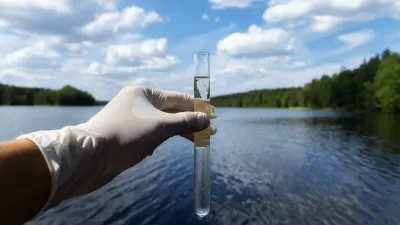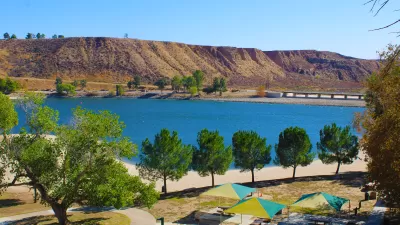According to scientists, increasingly salty lakes pose health risks not just to their fish and plant life but to the people who drink their water.

A study published in Proceedings of the Natural Academy of the Sciences found that in the 371 lakes observed, 44% showed evidence of long-term salinization. "No federal body tracks how much salt gets spread on our roadways or makes its way into our lakes. So the researchers hoovered up a vast number of different data sets, produced by states, municipalities and universities," Ben Guarino reports in the Washington Post. The study has big implications for drinking water around the country. "Extrapolating that finding for all of North America, at least 7,770 lakes are at risk of elevated salt levels — a likely underestimate," Guarino reports. This salt is coming, in large part, off roads and highways.
These salts cannot all be filtered out of drinking water. "Increased salt in drinking water poses health problems to humans who have kidney trouble, use dialysis or have hypertension," Guarino writes. And while some suggest that better management of salt use could curb the issue, there's evidence that salt consumption may continue to rise. "In winter 2014, the Wall Street Journal reported that road salt prices surged by 20 percent due to a huge demand," Guarino writes.
This exposes another challenge to the preservation of lakes in North America, which lost some of their protections following legislation from a Republican Congress, signed by President Trump, repealing Surface Mining's Stream Protection Rule.
FULL STORY: Salt from icy roads is contaminating North America’s lakes

Alabama: Trump Terminates Settlements for Black Communities Harmed By Raw Sewage
Trump deemed the landmark civil rights agreement “illegal DEI and environmental justice policy.”

Study: Maui’s Plan to Convert Vacation Rentals to Long-Term Housing Could Cause Nearly $1 Billion Economic Loss
The plan would reduce visitor accommodation by 25% resulting in 1,900 jobs lost.

Planetizen Federal Action Tracker
A weekly monitor of how Trump’s orders and actions are impacting planners and planning in America.

Waymo Gets Permission to Map SF’s Market Street
If allowed to operate on the traffic-restricted street, Waymo’s autonomous taxis would have a leg up over ride-hailing competitors — and counter the city’s efforts to grow bike and pedestrian on the thoroughfare.

Parklet Symposium Highlights the Success of Shared Spaces
Parklets got a boost during the Covid-19 pandemic, when the concept was translated to outdoor dining programs that offered restaurants a lifeline during the shutdown.

Federal Homelessness Agency Places Entire Staff on Leave
The U.S. Interagency Council on Homelessness is the only federal agency dedicated to preventing and ending homelessness.
Urban Design for Planners 1: Software Tools
This six-course series explores essential urban design concepts using open source software and equips planners with the tools they need to participate fully in the urban design process.
Planning for Universal Design
Learn the tools for implementing Universal Design in planning regulations.
Caltrans
Smith Gee Studio
Institute for Housing and Urban Development Studies (IHS)
City of Grandview
Harvard GSD Executive Education
Toledo-Lucas County Plan Commissions
Salt Lake City
NYU Wagner Graduate School of Public Service





























